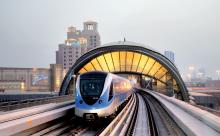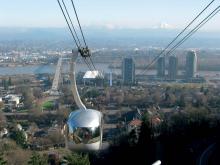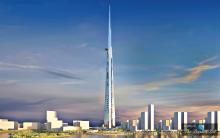David Crawford watches the race to get the world's first PRT system up and running. To paraphrase the old joke about buses bunching, you seem to have to wait several decades for a Personal Rapid Transit (PRT) system, and then half a dozen come along together. Currently, in fact, there are well over that number of schemes for driverless electric passenger-carrying 'pod' networks at various stages of planning, design and implementation around the world. Locations range from a straight-off-the-drawing board ne

PRT offers taxi-style privacy
David Crawford watches the race to get the world's first PRT system up and running.
To paraphrase the old joke about buses bunching, you seem to have to wait several decades for a Personal Rapid Transit (PRT) system, and then half a dozen come along together. Currently, in fact, there are well over that number of schemes for driverless electric passenger-carrying 'pod' networks at various stages of planning, design and implementation around the world. Locations range from a straight-off-the-drawing board new eco-community in the Gulf to established cities across Europe and North America.Originating in the 1950s as a proposed alternative to urban motorways, but burdened by images of clumsy-looking elevated structures (and one surviving scheme at the University of West Virginia, USA, that endured early problems), PRT had has to wait for more propitious times.
The race to deployment
It needed the arrival of modern computers, control technologies, and vehicle construction and integration systems to reappear centre stage. PRT is now emerging as a potentially serious, highly flexible contributor to meeting the congestion- and pollution-driven need for much greater modal shift, with vehicles that can be 70 per cent more energy-efficient than cars and 50 per cent more so than conventional buses.A race to have the world's first operational system up and running with battery-powered pods by autumn 2009 is now on between London Heathrow Airport, which staged live demonstrations and an international conference on PRT in April, and the Gulf. PRT is the specified main mode of urban transportation for Masdar ('The Source') City.
The Masdar Initiative
On the outskirts of Abu Dhabi City, the capital of the United Arab Emirates (UAE), Masdar City forms the heart of the US$15bn Masdar Initiative, where groundbreaking took place in February 2008. Denver, US-based engineering contractorsDesigned by UK architects Foster and Partners for a population of 50,000, the planned zero-carbon, waste-free community of Masdar aims to save over more than $2 billion-worth of oil over 25 years and serve as a benchmark for a future generation of green design. It makes no provision for fossil-fuelled vehicles on-site; car-borne arrivals will have to park outside.
External public transport connections will be via Light Rail Transit (LRT) and underground metro services to Abu Dhabi city and airport. Inside, pedestrians (and Segway users) will move freely through a traffic-free environment of shaded walkways and narrow streets designed to reduce solar gain and glare.
Running along underground guideways, PRT will provide an intensive public transport network aimed at ensuring that no resident will be more than 200m away from the nearest pick-up point. It will use three vehicle types: six-seater passenger carriers, cargo carriers and recyclable waste carriers. (The idea is to encourage maximal recycling, with 99 per cent of waste generated being re-used or composted).
The eventual network will have 83 stations spaced at 400m intervals. A fleet of some 3,000 vehicles, running at 40km/h, is being phased in over the period to 2015.
The developer of the vehicles for Masdar is the Netherlands' automated people mover specialist 2getthere, a subsidiary of industrial guided vehicle pioneer Frog Navigation Systems which is already running in-warehouse installations. Its pods, powered by advanced lithium iron phosphate batteries, travel on tracks pre-fitted with embedded magnets located at 5m intervals.
The vehicle uses these, together with onboard-derived information on speed and wheel angles, to identify its location. Boarding passengers will choose a destination, and the system computer will then decide a route for the pod for its own onboard computer to maintain.
London Heathrow's solution
At Heathrow, airport operatorRunning non-stop, the pods will offer taxi-style privacy. Further extensions across the airport are on the drawing board.
Heathrow's pole position in European PRT implementation was to have been held by the Welsh capital, Cardiff, where plans for a link between the city centre and the Welsh Assembly Government in Cardiff Bay failed in 2003. ATS maintains a 1km test track there.
Europe had already evinced reawakening interest in PRT with the 2002-5 Evaluation and Demonstration of Innovative City Transport (EDICT), which looked at the potential in Cardiff and three other cities: Almelo (the Netherlands; a link between the city's railway station, centre and hospital);
Ciampino (Italy; an 11km connection from the city centre to Rome's second airport); and Huddinge (Sweden; a shuttle between public transport and car parks and Scandinavia's largest out-of-town retail and leisure park).
Despite seeing PRT's clear benefits for European cities, EDICT concluded that "unfortunately, nobody wants to be the first, and that has had a lot to do with politics". Commitment by the UAE authorities and BAA, and the operational experience to be gained over the next few years, could well change the politics.
CityMobil
Meanwhile, the current EU-supported €11 million CityMobil project (2006-11), led by Netherlands applied scientific research organisation TNO, is looking at four further cities: Gateshead, in the North-East England Tyne and Wear conurbation; the Spanish and Austrian capitals of Madrid and Vienna; and Trondheim, a small community in northern Norway. Its conclusions to date include: an inner-urban PRT network can be viable in most types of city, but less so in larger ones; and PRT could usefully act as a suburban feeder to existing transport interchanges.Activity is also under way well beyond the range of EU projects. In Sweden, for example, consultants WSP have analysed the economic viability of PRT in 59 cities, the largest being Göteborg with a population of just under 0.5 million. It concludes that, at a cost of €8 million per pod/track km, there could be 10 'socially profitable' locations with populations of 100,000-plus.
Reducing the cost figure to €6 million, WSP would enable 22 'socially profitable' locations with minimum populations of 45,000. An urban PRT network could reduce average door-to-door journey times by 59 per cent as compared with buses; a chassis-only version could carry freight.
Bus, LRT and PRT
A detailed comparison study between bus, LRT and PRT is currently under way in Uppsala, the location of a test site for Swedish PRT developer Vectus. As the means of propulsion, its system uses in-track linear induction with power collection or onboard storage and, says the company, can easily be brought inside buildings.Potential tourist applications are already emerging from a preliminary study by the University of Bologna of the Italian Adriatic coast resort of Rimini. The completion, in autumn 2009, of the new Palacongressi Convention Centre, 3km inland, is expected to add to traffic pressures already being generated by the city's hotels and visitor attractions, including the proximity of the landlocked Republic of San Marino, which itself attracts over three million tourists a year.
The concept envisages closing the environmentally sensitive coastal area to non-residential coastal traffic. Instead, a bi-directional PRT network will connect Rimini railway station and a future park-and-ride on the A14 Adriatic motorway with the city centre, Palacongressi and hotels (none of which will be more than 150m from a station). Inclusion of strategically located buffer stations will help to cope with fluctuations in demand, which cargo consignments could also serve to even out.
Early financial analyses are apparently looking positive, subject to clarifications on operation and maintenance, and the feasibility of projected three-second headways, on which the University hopes that the first year of ULTra operation will show light. It sees scope for applications in other tourist destinations along the Adriatic coast.
US initiatives
Similar pressures exist in the US, where the Wyandotte County Unified Government in Kansas is currently investigating the possibility of funding, through President Obama's recently launched economic stimulus package, as well as from the State of Kansas's own Sales Tax and Revenue (STAR) bond system, for a PRT scheme. This would help solve growing traffic and mobility problems in the Village West retail and entertainment area on the western edge of the Kansas City metropolitan area.There are plans for a new casino and watersports resort to join the existing Kansas Speedway NASCAR race track and minor league baseball park. Much of the present land area is already taken up with car parks and access roads serving the attractions.
PRT could free a large percentage of this for further development. It would also improve inter-accessibility between the visitor draws and deliver feeder links to existing and planned public transport services.
Structural studies have drawn on Arup's ULTra development work in Cardiff. Colorado-based consultants PRT Consulting have now designed an optimal 16km route with 20 stations, one serving a park-and-ride.
A homegrown US PRT product, Taxi 2000's SkyWeb, uses in-vehicle linear induction for propulsion and maintains a test site in Minnesota.









